Last updated: 24th October 2021
We flew from Hanoi to Hue (instead of taking the 15 hour train ride!) it was the next stop on our tour of Vietnam. We didn’t know much about Hue, apart from it’s steeped in history and chose it as part of our tour to learn about Vietnam’s past.
The night we arrived in Hue it was a full moon and the start of a two day national celebration to honor their ancestors. On the journey from the airport to our hotel, roadsides were all lit up by fire, local people were outside their shops and homes burning fake money among other things in exchange for prosperity and good luck. The Vietnamese take respecting the dead and honoring their ancestors very seriously. It was also was very humid, but that was nothing compared to the humidity that was to come further south in Vietnam!
Table of Contents
Historic Hue
Hue was Vietnam’s capital for centuries when Emperors ruled from 1802 – 1945 (albeit as puppets under French rule from 1885). In 1945 everything changed when the communist government took over the North and South Vietnam was established by the French. Hue was where we witnessed our first sight of Vietnam’s tragic war-torn past.

View of Hue and the Perfume River

Skyline of Hue
We stayed at the Muong Thanh Holiday Hotel, which had lovely views at breakfast over the Perfume River and the Truong Tien Bridge. It was a good location for restaurants and shops in the evenings, where we had some bargain meals. This area also had many hawkers selling an array of paper cut out greeting cards, for a dollar, in fact all we could hear on the streets was “One Dollar?, One Dollar?” or them taking the mick, “Maybe Later”. Garth even bartered for the first time buying some fridge magnets and also bought a new camera card, although we’ll never be sure if it was a fake.
War torn Imperial City
Hue’s biggest attraction is The Imperial City – a walled city (a citadel) and within this is The Purple Forbidden City. They are located within the wider walls of the original old town citadel. Confusing or what?! – basically Hue has 3 citadels all within each other and the best known one is called The Imperial City, a UNESCO World Heritage Site. Unfortunately the Imperial City is a shadow of it’s former glory.
In 1968 Hue became an important and symbolic city of The Vietnam War (as we call it in the West, the Vietnamese call it The American War) and the Imperial City was fiercely fought over by the American and North Vietnamese armies during the Tet Offensive, a major campaign of the war. The result was devastating with many of Hue’s national treasures lost and The Imperial City suffering terrible damage when it was almost destroyed by heavy bombing from American forces, just 10% remains today.

Ngo Mon Gate gateway to the Imperial City
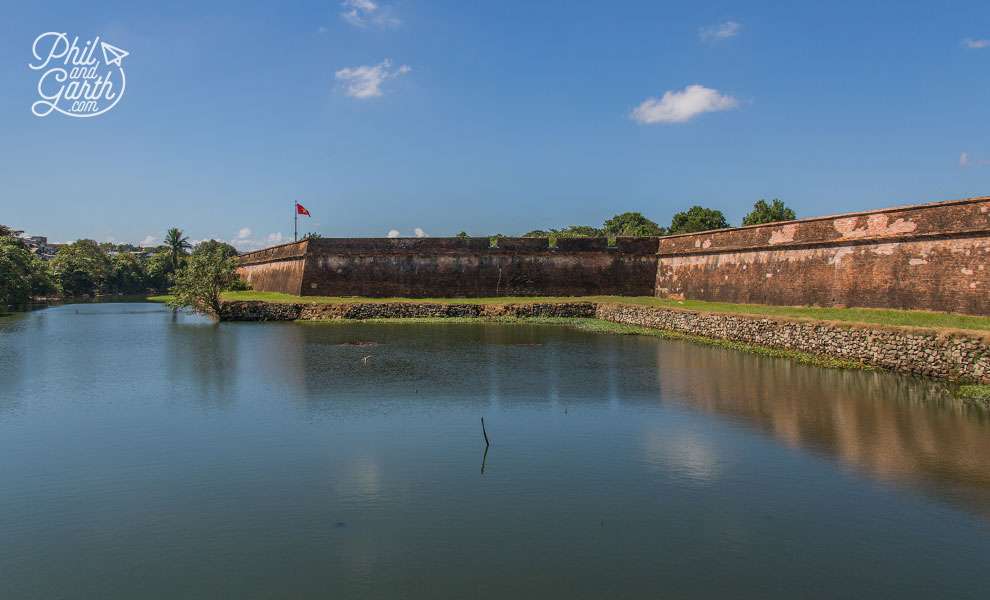
The outer walls of the citadel
The impressive stone walls of the Imperial City citadel are 10 metres thick and surrounded by a small moat with water fed from the nearby Perfume River. We saw noticeable scars of the war in many parts of the wall – bullet holes or repairs from damage.
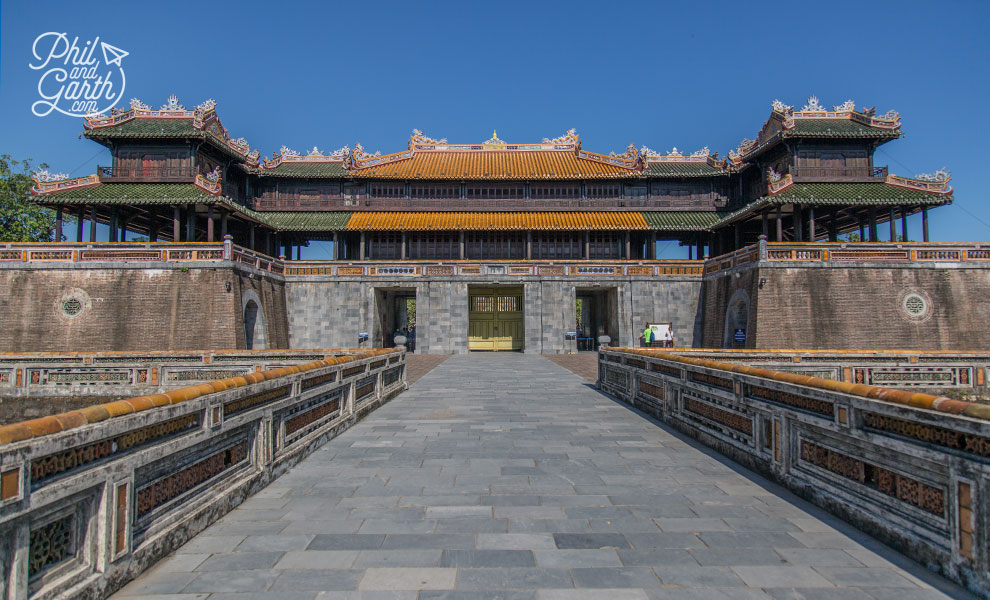
Ngo Mon Gate gateway to the Imperial City
Fortunately the main gateway into The Imperial City, Ngo Mon remains intact, and gives you a glimpse of how it all would have looked. The King would have entered through the yellow door in the middle, his mandarins through the doors left and right, and his elephants and horses through the tall arches at the sides.

Ornate decoration with tiles
Look up to and admire the ornate tile work on the roofs.

Hue’s Flag Tower called the King’s Knight
Opposite the main entrance is Hue’s massive 37 metre Flag Tower, the biggest flag and flagpole in Vietnam, it’s visible for miles around.

Inside The Imperial City
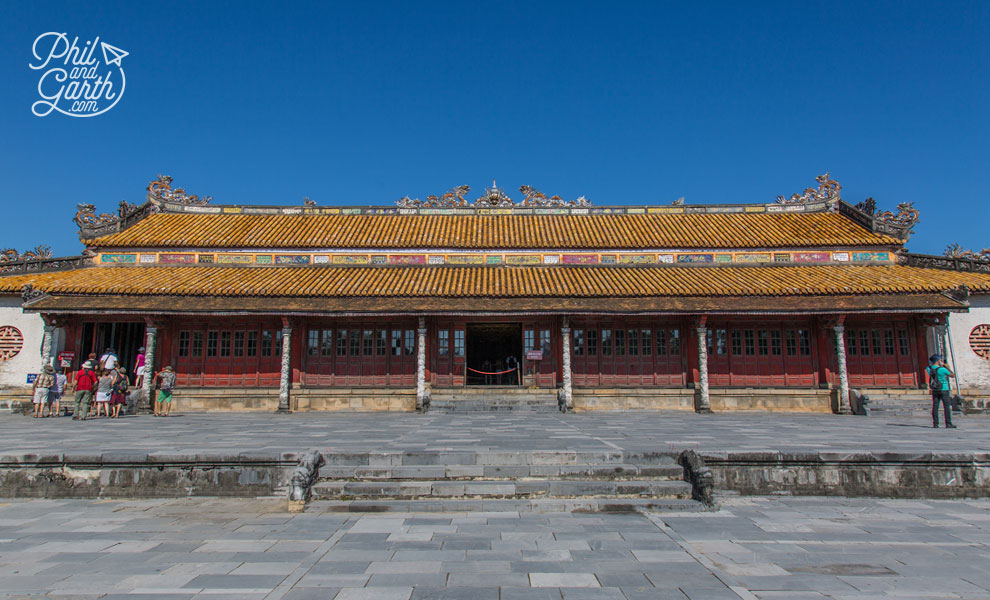
Thai Hoa Palace
Inside the first courtyard is Thai Hoa Palace – The Kings throne room, which luckily escaped serious damage, and easily the most impressive out of all the buildings remaining. You are not allowed to take photographs inside, but 80 massive wooden pillars are beautifully decorated in red and gold with dragons, an emblem of the Nguyen Dynasty.

Doors of the King’s throne room
Because we were there during Hue’s full moon celebrations, there were various offerings next to the King’s throne, as he have would have been there too – albeit in spirit.

The Vietnamese double happiness symbol is everywhere

View to The Purple Forbidden City
As you come out the other side of the King’s throne room, you face The Purple Forbidden City which was modelled on The Forbidden City in Beijing. It’s another citadel, so a fortress within a fortresses, but not much of it remains, just a handful of buildings.
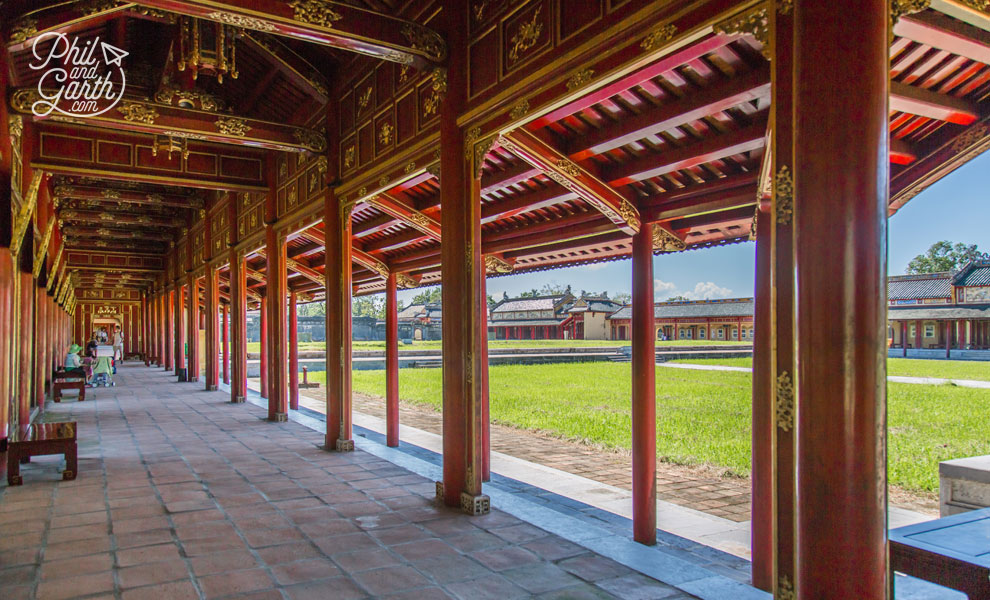
These hallways and doors did survive the bombing
The Purple Forbidden City had a lower perimeter wall and was exclusively for the King and Royalty. It would have contained his residential quarters, as well as those of his concubines, the courtrooms, tombs and temples. It was built to have views of the mountains behind and the Perfume River in front.

Ornate wooden doors line remaining hallways
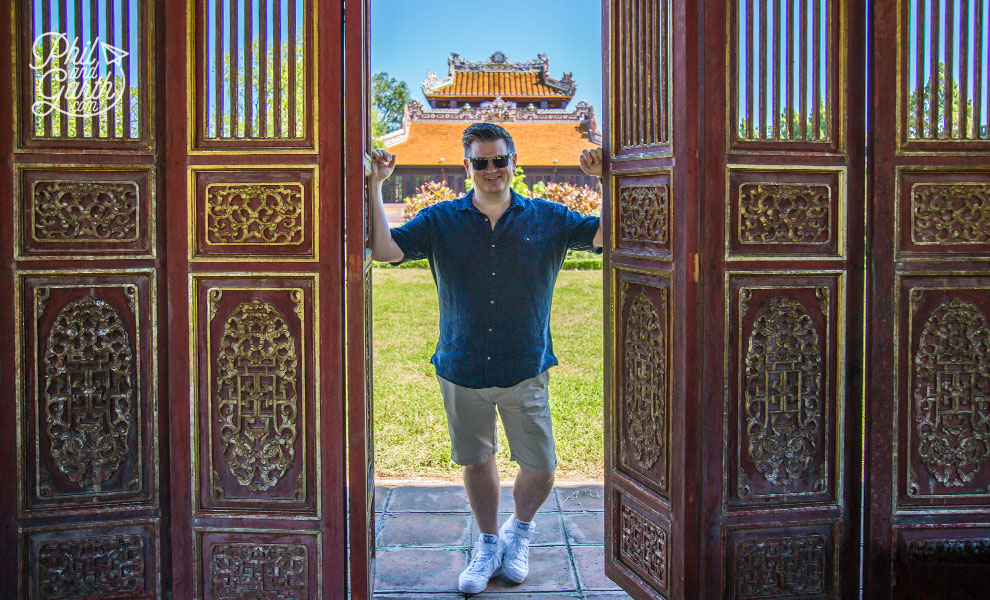
Phil inside The Purple Forbidden City
If you are thinking everything looks Chinese painted red and gold, that’s because the Vietnamese interpreted old Chinese imperial architecture and made it their own.

An old gate within The Imperial City
As we walked around the Imperial City trying not to get sunstroke (take plenty of water as always) we kept passing through more gates in various states of repair.

An old gate within the Imperial City
some worse than others, but these will look stunning one day when they are restored.

An old gate within the walls of The Imperial City
The shade of the trees along this path made a welcome rest bite from the hot sun and humidity.
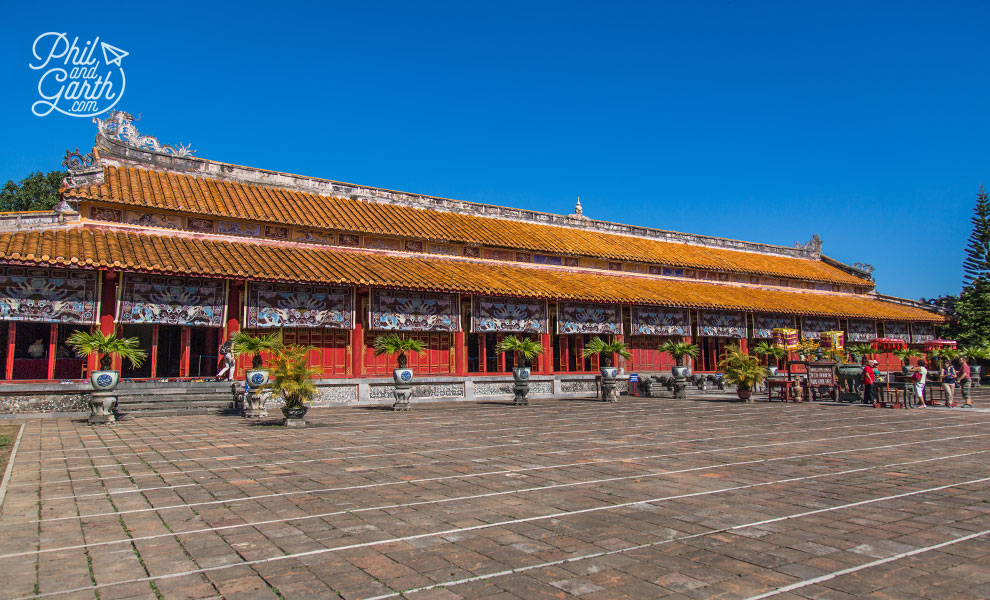
The Mieu – Temple of the Generations
The Mieu – The King’s private temple still stands, and is an another impressive sight.
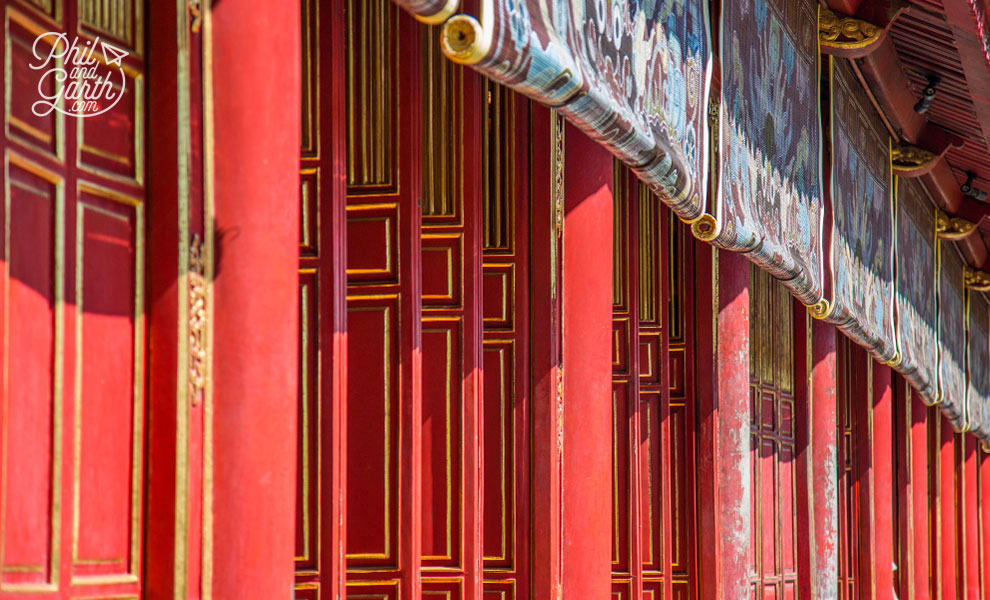
Bright red doors of The Mieu Temple

Close up of the tile designs

Ornate roof decoration

The Mieu Temple
Outside in the courtyard are 9 massive bronze pots decorated with bas-reliefs that were used for worship.

Damaged walls within The Imperial City
Basically where you see grass there would have been more Royal buildings. Most of the ruins have been cleared and even though a lot of what still stands is in quite a crumbling state, the good news is they have detailed plans and photographs how it all once looked, and a few buildings have already been reconstructed, including a replica of the Royal Theatre. As visitor numbers increase to Hue, the extra income will no doubt help with restoring The Imperial City to its former grandeur as Hue looks beyond its past and embraces tourism.

The other walls of the Citadel
The moats around the outer walls were filled with bright pink water lilies.
Cyclo Ride
From the Imperial City we took a cyclo back over the Perfume River to the new city.

One of Hue’s Citadel gates

Truong Tien Bridge
Crossing the Truong Tien Bridge, this is another place where fierce fighting took place during The Tet Offensive.

Garth, looking like he has escaped from a day care centre!
Perfume River & Thien Mu Pagoda
The Perfume River was once lined by fragrant Frangipani trees, which is where it gets its name from. We took a Dragon Boat along the river for our next landmark The Thien Mu Pagoda about 3 miles from Hue.
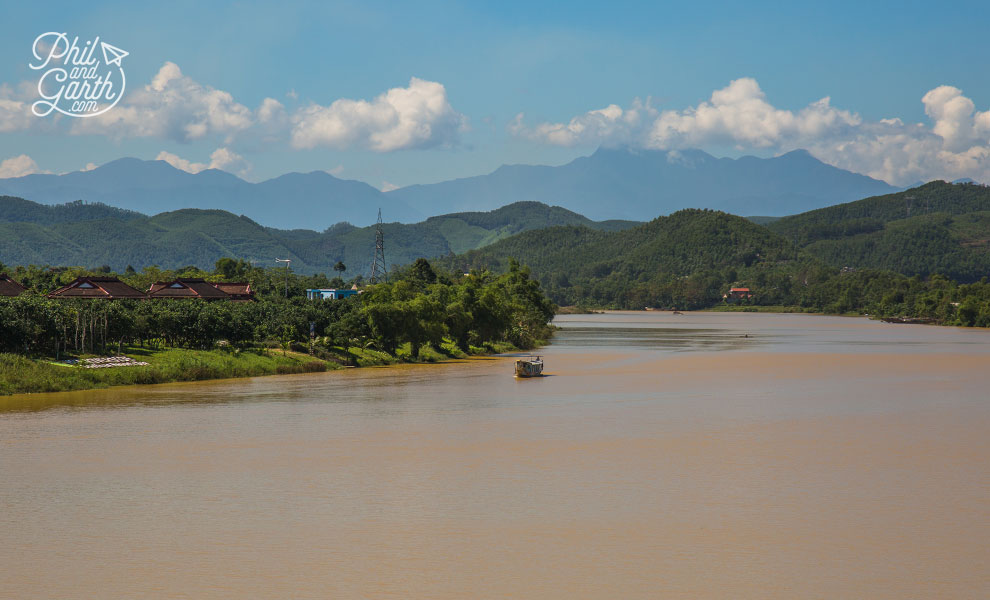
The Perfume River

Colourful dragon boats
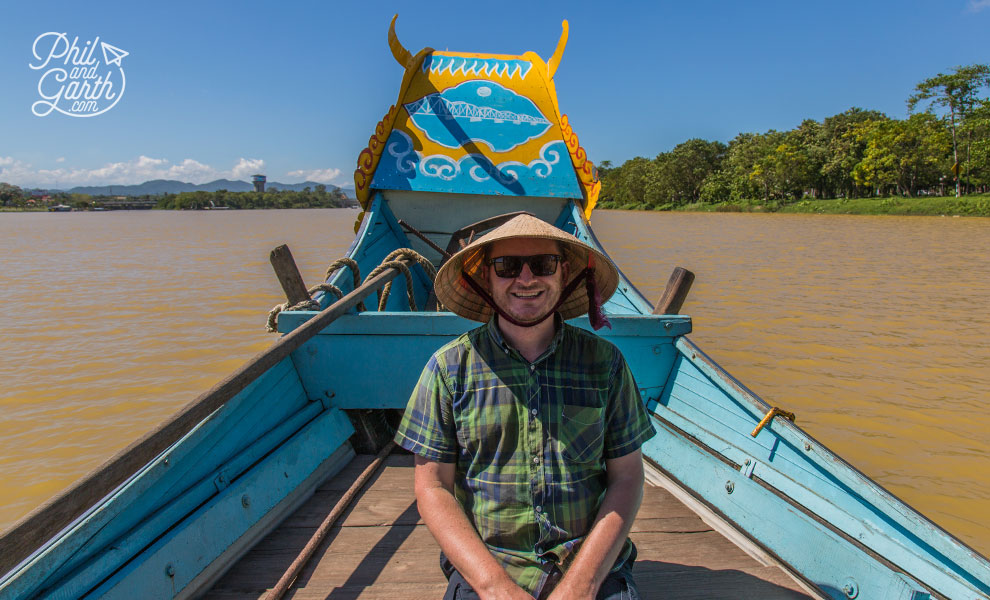
Garth on the Dragon boat along the Perfume River
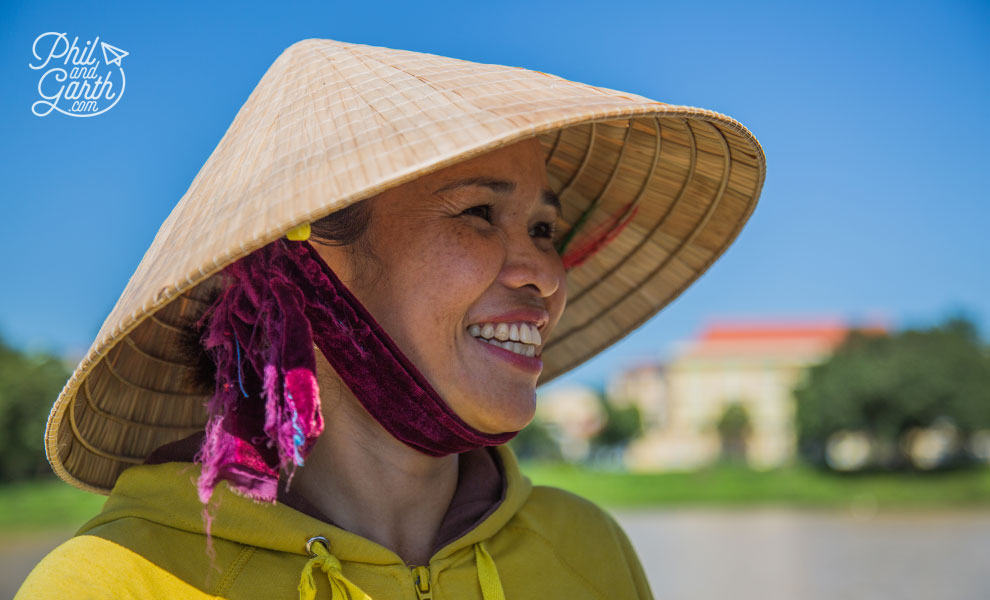
Our dragon boat lady kindly posing for a photograph

Thien Mu Pagoda
After 45 minutes we arrived at the Thien Mu Pagoda, an octagonal stepped 21 meter high tower, the tallest in Vietnam. Dating back to the 17th century. It’s an intricate pagoda surrounded by pine trees.
Scooter Tour ride to Hue’s countryside
We nervously decided to take a scooter ride into the countryside. Neither of us have ridden on the back of a bike before, let alone in crazy traffic a million miles from home, but it turned out to be a fascinating insight into local life.

Phil and Garth taking at scooter ride to the countryside

City centre traffic
Once we had left Hue’s busy city centre, we’re comfortable with the bikes and Garth felt confident enough to use his big camera.
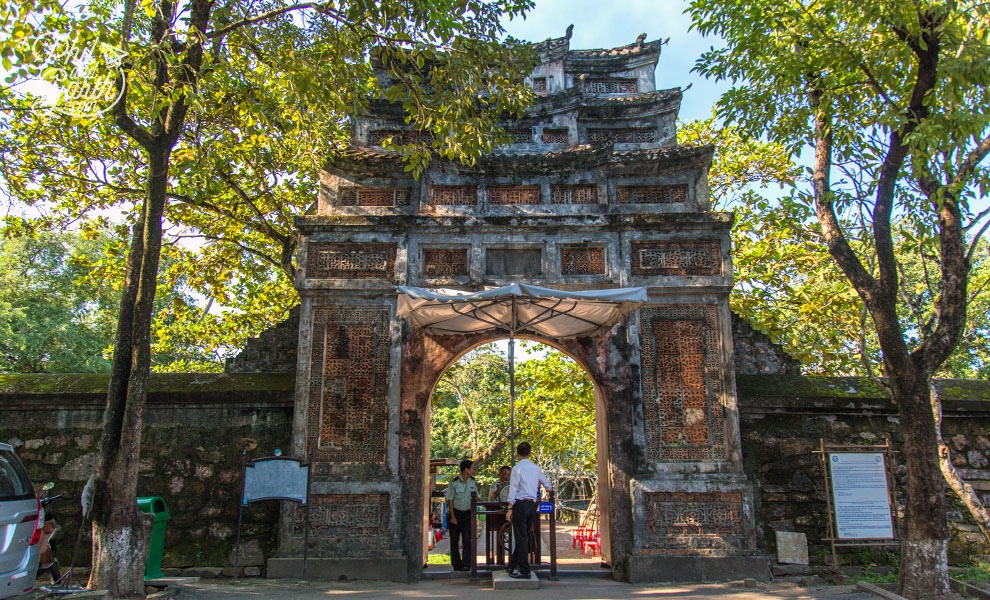
A Royal Tomb entrance gate
Most people heading to the countryside visit one of the several Royal tombs that are dotted around the area close to Hue. Some of these mausoleums are really grand in scale, others more modest set in woodlands. We didn’t go inside, as we really want to see farming in action and the villages to see how people live.

Phil in the rice fields
After riding off road on some crazy dirt tracks through woodlands, we were back in the open and in the rice fields, where it looked liked most had been harvested. Phil enjoyed looking at the engineering of the lock gates used to flood the fields.
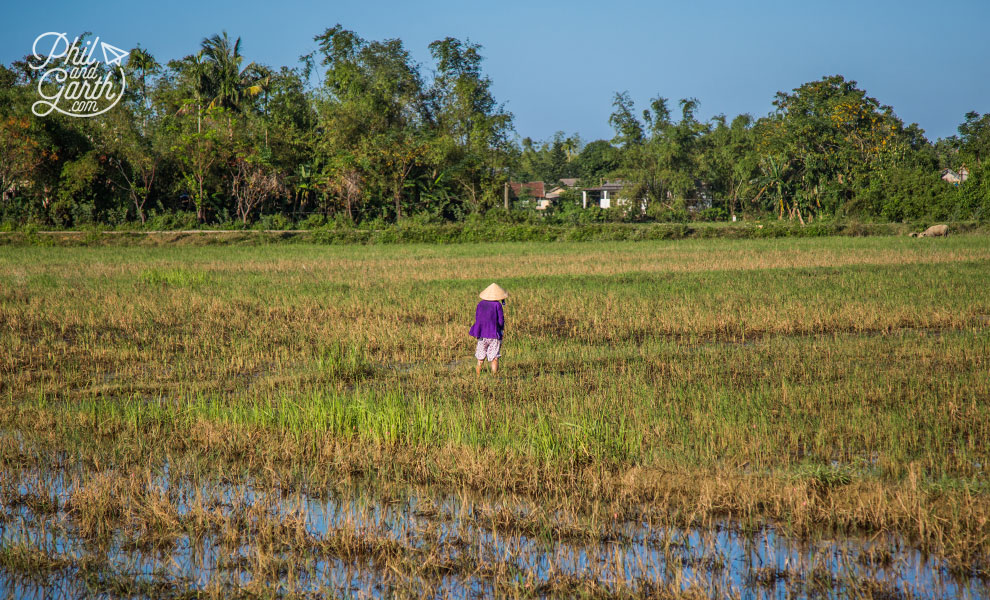
Rice farmer in Hue countryside

Farmer in Hue countryside

Scooter riding through a small village
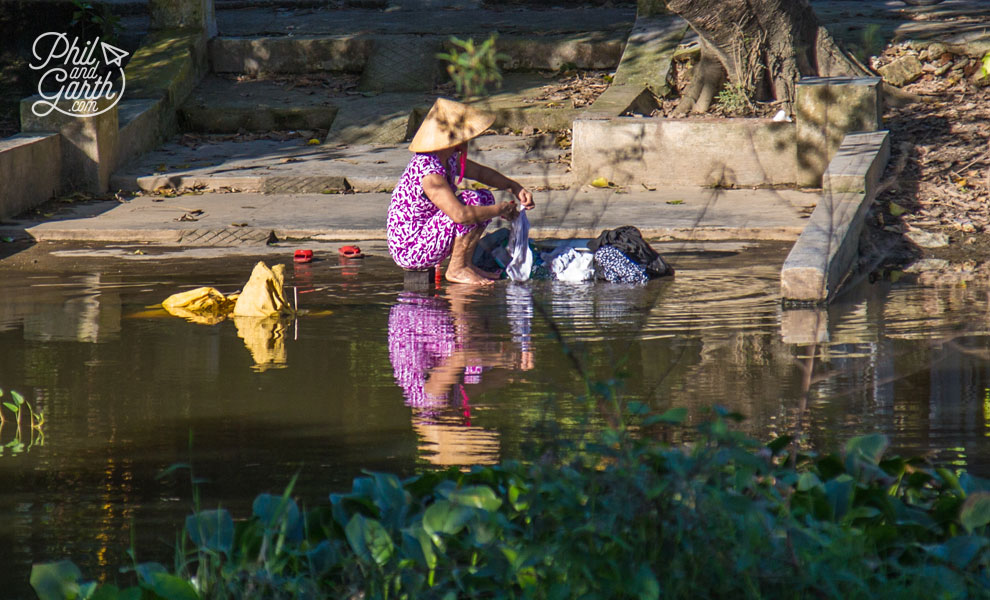
Washing clothes in the river

Stunning patterns made with Incense sticks

More colourful displays
Garth loved these displays of incense sticks, and how they used the sticks to create simple but beautiful displays of colour by fanning them into patterns.

Thanh Toan Tile Bridge
We had a look at the second oldest Japanese bridge in Vietnam called the Thanh Toan Tile Bridge in the village of Got Thanh Thuy which is about 6 miles from Hue. It bears a striking resemblance to its more famous cousin in Hoi An. This one was built in 1776 and is beautifully decorated with 200 year old tiles.

Thanh Toan Tile Bridge
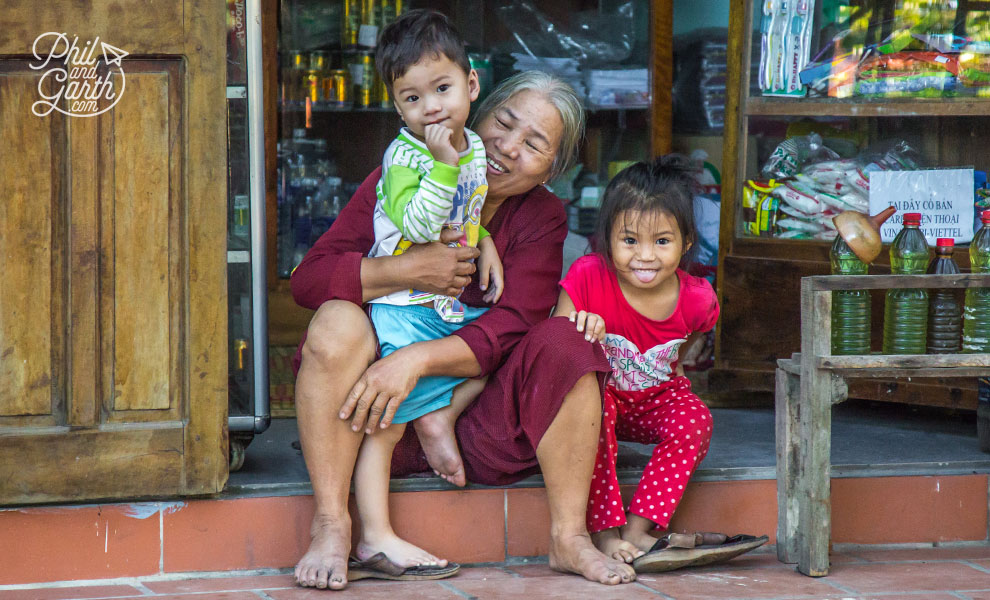
Friendly locals kindly posing for photographs
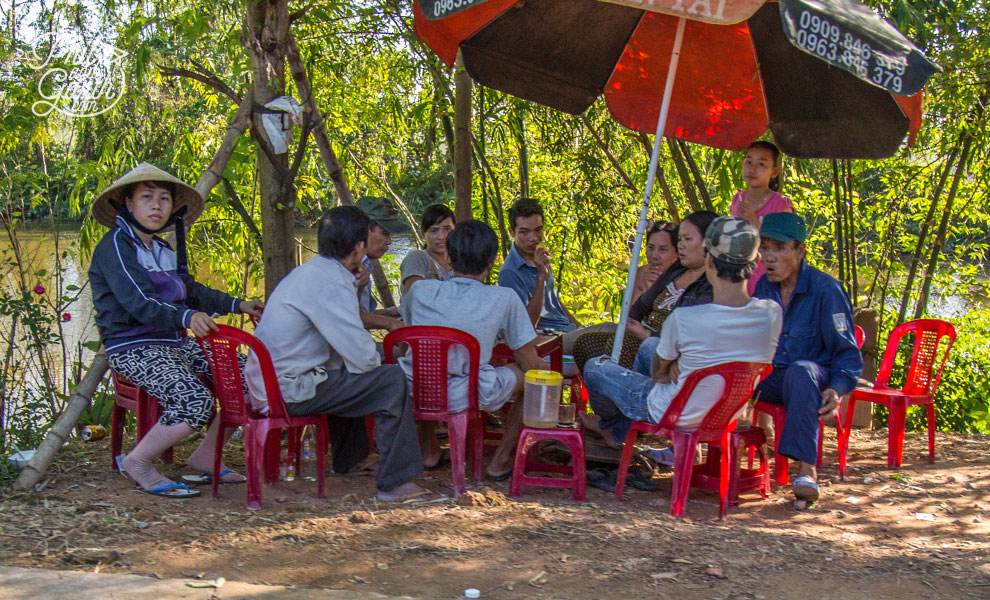
People relaxing in the shade

Typical road scenes
This scene was not usual, livestock simply wander all over the roads we passed goats, cows and water buffalo.

Scooter ride back to Hue

Old Olympic stadium in Hue
Heading back to Hue and we passed the city’s old Olympic stadium, to our knowledge Vietnam has never hosted the Olympics? It was built by the French in the 1930s who named it ‘Stade Olympique de Hué’ it’s now the home of Hue’s football club.
Food & Drink
Across Vietnam we tried all the local dishes, and Hue was no exception. Dishes are certainly more spicier in Hue. For lunch we stopped at a lovely French restaurant within the first outer walls of the Citadel Les Jardins De La Carambole and had Com Hen – a simple dish of baby mussels, cabbage and rice in a chilli sauce and another dish called Banh Khoai – a sizzling pancake with pork, beansprouts and egg which tasted like a crispy omelette, which was our favourite.

Com Hen

Nem Lui – Pork lemongrass skewers
Around the corner from our hotel we tried Elegant Restaurant, despite being full of Westerners, the food was really good and cheap! – £9 for 4 beers, Nem Lui (pork on lemongrass skewers that you DIY into spring rolls) and Cau Lau (a yellow noodle dish with pork) bargain!

Hue’s local beer – Huda
And of course had to try the local beer Huda.
Hue Practical & Useful Information

Garth and Phil in The Imperial Citadel
Phil and Garth’s Top 5 Hue Tips:
- Tip #1: Hue is pronounced “h-wey”
- Tip #2: Protect yourself against mosquitoes – use insect repellent with at least 50% Deet content
- Tip #3: Heading to the countryside? Avoid stagnant water – this is where mosquitoes breed.
- Tip #4: Hue is hot & humid so cover yourself in sunscreen and drink water in the scorching heat.
- Tip #5: Heavy rain can cause flooding between October – December.
How We Did It
- We paid for a small group guided tour of Vietnam (Vietnam & Cambodia Uncovered) with Inside Asia Tours



25 comments
I didn’t visit Hue when I was in Vietnam, so this is a treat to “see” it through such beautiful photos. I love that tile mosaic wall! The scooter ride looked awesome (what a fun experience!) and how nice to be able to explore the countryside and small villages – those are always the parts that interest me the most!
Superb pictures as usual. And great info. Hue looks lovely. little trailer/video at the top of the page is a nice touch!
The bridge on the perfume river looks like it could give a decent reflection for a photo. The scooter ride into the countryside of Hue looks like a fun day out, it looks like the drivers were enjoying it too. I never knew this was the capital, I actually had never heard of Hue before I read this.
As always, your post and pictures are amazing. I haven’t been to Vietnam but hopefully we will get there soon. Hue seems to be a great travel destination with a lot of history behind. I admire your courage to ride a scooter, I was too scared to try it in Thailand or Cambodia. The 1 dollar card made me laugh, so typical for SE Asian countries. Thank you for sharing.
Your photos are spectacular! We would love to visit Vietnam and your post is full of useful information. Have pinned for future reference. #feetdotravel
The dragon boats were my favorite part! We have a huge dragon boat festival every September in Portland, Or. Your pictures were magical. We can’t wait to check out Vietnam one day.
Ok, I’m just gonna ask it… why did you decide to fly instead of take the train? That totally sounds like something I would do! This is beautiful and, as usual, I love the vibrant colors and character you’ve captured. I’ve never heard of the Perfume River either… I feel like I learn so many new things from your posts!
I can’t get over how much I love your travel posts. You pack so much great information into one page, complete with incredible photos… I a) feel like I’m in Hue and b) wish I WAS in Hue. What an incredible place, full of culture and intricacy. There’s not enough time to comment on every single thing you wrote, but I wish there was ’cause I’m stunned. The details of the palaces, the design in the tiles (so pretty), the rice fields (I’d love to see those in person someday), the honoring of the ancestors, the food!
I wish we had more time to travel, because I’d go everywhere in this post. What an experience, guys. Thank you for sharing yet another incredible post with us! 🙂 #feetdotravel
Ah thanks for your kind words, It really was a great experience, like you wish we had more time!!
Hue looks like such a fascinating city and the surrounding area. I missed this city and will have to return and visit. There is so much history there. How great, feeling confident to sit on the back of a scooter and Garth shoot pictures. 🙂 Then Phil do some bargaining…that is what I call having fun 🙂 Great tips with stunning photos and video. They love dollars there and a good tip is to take lots of US $1 bills. Thanks for sharing love this 🙂 #feetdotravel
You’re right Stephanie about the $1 bills, the other thing we noticed was they don’t like old banknotes for some reason, but happy with crisp new notes.
I had a good chuckle about the photo card! Love the pics too!! xoxo
only 1 dollar!!